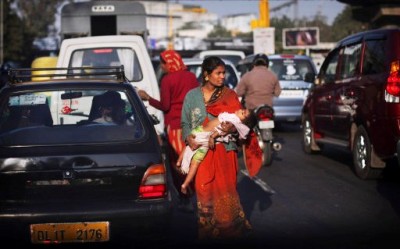BeyondHeadlines News Desk
National Safe Motherhood Day is observed on 11 April every year. The theme for this year is “Every Woman Counts”. It aims at enforcing the strong voice that all women should have access to care and no maternal death is acceptable. Surviving childbirth is a basic right of every woman and each individual directly or indirectly associated with the issue has a social responsibility to ensure that every woman counts.
The Millennium Development Goal (MDG) 5 has set a target for reducing maternal mortality to 109 per one lakh live births. Achieving MDG 5 is not only an important goal in itself, it is also central to the achievement of the other MDGs: reducing poverty, reducing child mortality, stopping new HIV infections, providing education and promoting gender equality.
This brief argues that maternal deaths can be prevented by increasing the institutional delivery, reducing anemia among women and adolescents by IFA supplementation and by providing better postnatal care for mothers. It also argues that other indirect causes of maternal deaths like child marriage must be stopped and education of girls encouraged.
Situation in India and Jharkhand
About 8.3 lakh women deliver every year in Jharkhand. Of these, about 2,200 women die during child birth, considering Maternal Mortality Ratio (MMR) of 261 deaths of mothers for one lakh live births. Maternal health is a human right – failure to provide maternal healthcare is a violation of woman’s right to life, health, equality and non-discrimination. No woman should die giving birth.
The MMR in Jharkhand is 261 per one lakh live births, compared to 212 in India (SRS 2010). The MMR in the state is steadily declining – from 531 in 1997-98 to 400 in 1999-01, 372 in 2001-03, 312 in 2004 and 261 in 2010.
| Indicator |
Source |
Jharkhand |
India |
| Maternal Mortality Ratio (MMR) (per 1 Lakhs live births) |
SRS 2010 |
261 |
212 |
|
AHS 2011 |
278 |
– |
|
| Proportion of births attended by skilled health personnel |
NFHS 3 |
29.1 |
48.2 |
| Institutional delivery (%) |
AHS 2011 |
37.6 |
– |
|
NFHS 3 |
19.2 |
40.7 |
|
|
Coverage Evaluation 2009 |
40.1 |
72.9 |
|
| Mothers who had three or more ANC (%) |
AHS (2011) |
56.3 |
– |
|
DLHS 3 |
30.5 |
49.8 |
|
| Mothers consumed 100 IFA tables (%) |
DLHS 3 |
56.3 |
46.6 |
| Births attended by skilled health attendants (%) |
NFHS 3 |
29.1 |
48.2 |
| Mothers who received postnatal care from skilled health personnel within 2 days of delivery of last birth (%) |
NFHS 3 |
17.5 |
36.4 |
Consequences of Mothers Dying during Child Birth
- Children are left motherless and vulnerable because of maternal deaths. Maternal health and newborn health are closely linked. Children who have lost their mothers are up to 10 times more likely to die prematurely than those who have not (UNFPA, 2012). Providing good quality care during and after pregnancy and childbirth will substantially reduce newborn deaths.
- When a woman dies or becomes ill, her children are much more likely to leave school and suffer from poor health. Her production and income are lost both to the family and her community. Therefore many lives are saved and national income rises when women have access to quality healthcare from skilled providers during labour, in child birth and after delivery.
How Can Death of Mothers Be Prevented
- Ensure delivery in hospitals/institutions or by skilled birth attendant
Major causes of maternal deaths in South Asia according to WHO (2010) are postpartum hemorrhage (35%), eclampsia (17%) and obstructive labour (11%). If institutional deliveries happen, deaths due to these causes (about 40 – 60%) can be prevented. At present only 37.6% deliveries are conducted in institutions (AHS 2011). Institutional deliveries have been steadily increasing in the state from 19% in 2006 (NFHS) to 37% in 2011 (AHS).
- Reduce maternal anemia and improve ante-natal care (ANC)
There are certain indirect causes for maternal deaths. These are anemia among adolescents and women, lack of care and food for pregnant women, lack of ANC, lack of education, etc. In Jharkhand, the prevalence of anemia among women (15-49 years) is highest amongst all states at 70.6%. Two-thirds of adolescent girls (15-19 years) are anemic. Maternal anemia is a major cause for death of mothers during delivery due to haemorrhage, sepsis, etc. It is important to ensure all pregnant women get IFA tablets and at least three ANC services during VHND (Village health and Nutrition Days).
- Postnatal care for mothers and newborns – Postnatal care (within 24-48 hours of delivery) includes monitoring mother for excessive bleeding, pain and infection, as well as counseling them on breastfeeding, nutrition and family planning.
- Stop child marriages – Child marriage is a major indirect cause for maternal mortality because of early conception and early delivery. Jharkhand has the highest rate of child marriage in India, after Rajasthan and Bihar with 51.8% of married women of 20-24 years in Jharkhand married before 18 years. Girls who become pregnant as adolescents have an increased risk of death. Their babies risk infection, malnutrition and death.
- Invest in girl’s education – Education is the best guarantee for preventing child marriage, empowering adolescent girls and ensuring better health.
UNICEF in Action
UNICEF has partnered with the Government of Jharkhand to promote simple interventions which can significantly improve maternal survival:
- UNICEF provides technical support to the government to introduce (in all 24 districts) the services of the Mamta Vahan. This is a 24×7 call centre service to ensure pregnant mothers reach PHCs/CHC, institutions for delivery.
- Support supplementation of iron in all age groups, especially adolescents and pregnant women. Adolescent girls both in-school and out-of-school are provided an iron tablets free of cost in schools and anganwadi centres under the Government’s Weekly Iron Folic Acid Supplementation (WIFS) programme.
- UNICEF supports quality assurance of training for skilled birth attendants. This is a 21 day in-service skills training which builds the capacity of nurses for life saving maternal and newborn skills.
- UNICEF supports health programs such as the Village Health and Nutrition Days (VHND) to reach out to pregnant women in underserved areas, ensuring that they receive the three essential antenatal check-ups, tetanus injections, IFA tablets (100 tablets over the period of 9 months of pregnancy) and sensitizes them about the importance of institutional deliveries.
- UNICEF works closely with National Rural Health Mission (NRHM) programs such as Janani Suraksha Yojna and Janani Shishu Suraksha Karyakram to encourage women to have institutional deliveries.
- Technical support for assessment and operationalization of First Referral Units (FRUs) for improving maternal and child health services through 24×7 delivery services, caesarian section facility and availability of blood.
- UNICEF supports community and facility based review of maternal deaths. It provides insight into gaps in maternal health service delivery which is reviewed by MDR committees for action.










